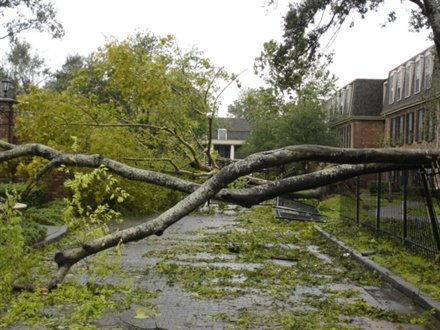[/caption]
NASA’s Johnson Space Center in Houston weathered Hurricane Ike fairly well, but damage to some buildings, including the roof of the Mission Control Center will need to be repaired before the facility is ready to open for normal operations. A space agency spokesman said it could be late this week or even sometime during the week of Sept. 21 before all the buildings would reopen. The 16,500 employees at JSC will also need to access and repair any damage to their own homes as well. JSC lost power, but essential systems were powered with generators. Controller for the International Space Station established a temporary control center at a hotel inland in Austin, Texas before Johnson was closed on Thursday. Working with another team at NASA’s Marshall Space Flight Center in Huntsville, Alabama, controllers are trying to fill in until Mission Control can re-open.
While there was some standing water, JSC was not affected by Ike’s Galveston Bay surge, but high winds caused roof damage and downed trees. Repairs and cleanup were under way on Sunday.
Meanwhile, the space agency has not assessed the impact of the storm on plans for the scheduled October 10 launch of the shuttle Atlantis on a mission to overhaul the Hubble Space Telescope and the November 12 date for launching shuttle Endeavour on a space station assembly mission, said David Waters, spokesman for United Space Alliance, NASA’s shuttle prime contractor.
Additionally, a resupply ship’s docking with the ISS was delayed, and it waits on orbit near the station. U.S. and Russian flight controllers hope to dock the unmanned Progress supply ship Wednesday at 2:43 p.m. EDT. The cargo craft was launched from the Baikonur Cosmodrome in Kazakhstan last Wednesday and originally was scheduled to dock Friday.
Sources: Houston Chronicle, Spaceflightnow.com


“a temporary control center at a hotel”. It is not to be believed! During Apollo the Goddard Space Flight Center near Washington DC (they were also the Agency’s lead center for communications) had a stripped down but fully functional backup mission control center, staffed and ready to takeover at a moment’s notice. During Apollo 17, our historic last mission to the moon, the networks did not care to air any of the moonwalks, so as a 16 year old I asked for and received permission from the Center Director (actually his secretary) and with my friend received access badges (which I have to this day) and watched all three walks from the GSFC viewing gallery. That NASA has no formal backup mission control center is just stupefying. It is yet another example of NASA’s resources spread so thin rather than being permitted to pursue the awesome goals that were once within reach.
Hey DCTechGuy – I’m sure back in the day of the Apollo missions that would have been the prudent thing to do. But with today’s technology and communications infrastructure, coupled with today’s financial responsibilities and cost cutting, I don’t see any reason or problem with controlling the ISS from a hotel room. In fact I would love to try it myself! I actually work as the Mission I.T. Specialist for the Australian Customs Coastwatch (possibly not quite as ‘high tech’ as the ISS, but close). I know for a fact (because I have to fix it if it doesn’t work) that if our national surveillance centre ever goes ‘down’, a customs officer can still control and command the entire fleet of 10 aircraft and 2 helicopters, as well as receive live streaming video, radar display, and target info from each, via a ‘portable remote node’ (basically a case with a laptop and a satellite link). So if we can do that, I’m sure NASA can do something similar to control the space station!